The Monk's Way - Historic Cossall Village
This page was revised from a previous page and
added to this site on 03 October 2004
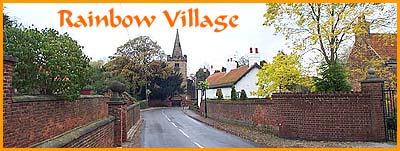
|
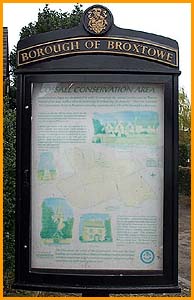 Where Fact And Fiction Come Together Where Fact And Fiction Come Together
Eastwood is a town that lies three or four miles from Ilkeston
just across the county border and its main claim to fame is that
it was the birthplace in 1885 of the novelist and poet David
Herbert Lawrence.
Lawrence found fame - and notoriety - with such stories as "Sons
and Lovers" and "Lady Chatterley's Lover"
taking his inspiration from his upbringing in the Eastwood area
as a coal miner's son. Educated in Nottingham, D.H. Lawrence
is now regarded as a great literary artist but the realism, bawdy
language and sexual explicity of his novels revolted many and
led to a court case in the 1960s when Penguin published "Lady
Chatterley". Whatever the merits or otherwise of the
novel the court case provided tremendous publicity and the book
sold in thousands.
Several of Lawrence's stories have been turned into films or
television dramas. At least one of them, "The Rainbow"
was actually filmed in the area and included some fairground
scenes in Ilkeston Market Place. Much of the action though was
centred on the village of Cossall in an area now designated as
a Conservation Area.
|
Cossall, although still in Nottinghamshire, is even closer to
Ilkeston than Eastwood. It was this village that Lawrence used
as the background for his 1915 novel "The Rainbow"
calling it Cossethay and many scenes in the TV drama featured
Church  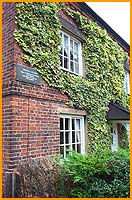 Cottage which stands next to the
village church. In real life, this was actually the home of Louie
Burrows to whom Lawrence was engaged for a time. The character
of Ursula Brangwen in the story is based on Miss Burrows
and a plaque on the wall of the cottage commemorates this association
- a place where fact and fiction come together. Since Lawrence's
work of fiction, the slate roof has been replaced by red pantiles
but a few rows of slates still peep out from under the eaves. Cottage which stands next to the
village church. In real life, this was actually the home of Louie
Burrows to whom Lawrence was engaged for a time. The character
of Ursula Brangwen in the story is based on Miss Burrows
and a plaque on the wall of the cottage commemorates this association
- a place where fact and fiction come together. Since Lawrence's
work of fiction, the slate roof has been replaced by red pantiles
but a few rows of slates still peep out from under the eaves.
|
 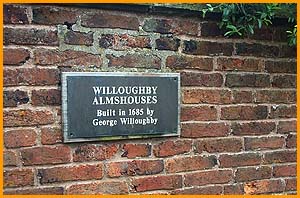
Today Cossall remains relatively unspoiled despite the amount
of traffic that negotiates the winding road through the village.
But those that care to stop and observe will also see another
plaque on the wall outside the 300 year old almshouses that stand
next to Church Cottage. It states that the Almshouses were built
by George Willoughby in 1685.
|
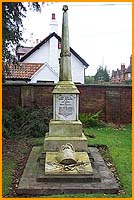 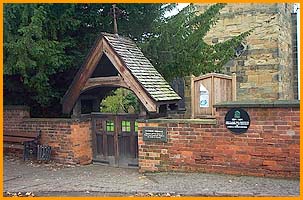 At the other side of Church Cottage, the lych gate to St Catherine's
Churchyard also leads to the Waterloo Memorial. Yet another plaque,
this one at the side of the lych gate informs us that the memorial
was erected in 1877 in memory of three men from Cossall who fought
at the Battle of Waterloo. The circular black plaque on the same
wall is inscribed "1894-1994 This plaque was erected to
commemorate the Centenary of Cossall Parish Council". St
Catherine's Church, which dates from the thirteenth century,
was rebuilt in the mid-1800s.
At the other side of Church Cottage, the lych gate to St Catherine's
Churchyard also leads to the Waterloo Memorial. Yet another plaque,
this one at the side of the lych gate informs us that the memorial
was erected in 1877 in memory of three men from Cossall who fought
at the Battle of Waterloo. The circular black plaque on the same
wall is inscribed "1894-1994 This plaque was erected to
commemorate the Centenary of Cossall Parish Council". St
Catherine's Church, which dates from the thirteenth century,
was rebuilt in the mid-1800s.
|
I am grateful to Mr Peter James for the loan of the following
1927 photograph of St Catherine's Church Choir.
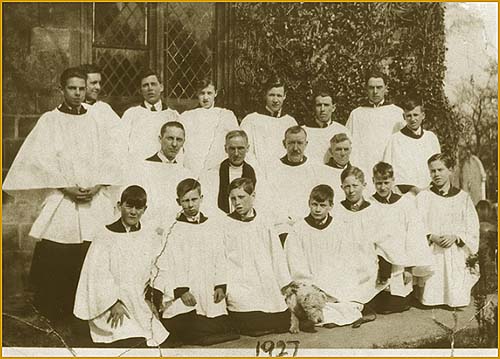
Back Row: Jack Truman Jnr, G. Abbot, G. Parson, H. Grayson Jnr,
L. Trueman, J. Truman Snr.
Middle Row: Scott Wheatley, Rev Billingham, School Master Mr
Randall, Mr Grayson Snr, P. Harrison, J. Wheatley.
Bottom Row: Jack Riley, C. Daykin, Walter Parsons, Allan Johnson,
B. Bonner, E. Instone, H. Bradshaw.
|